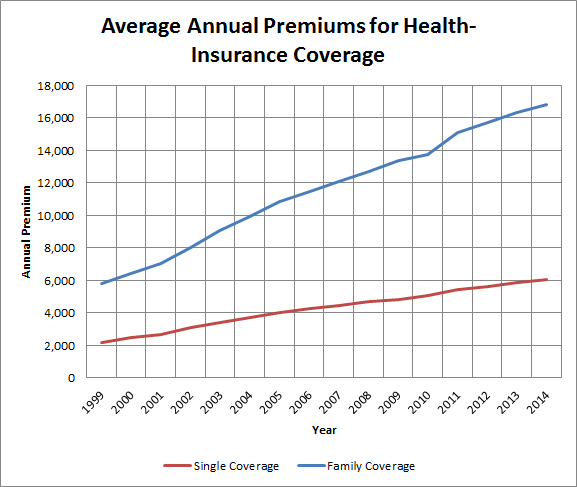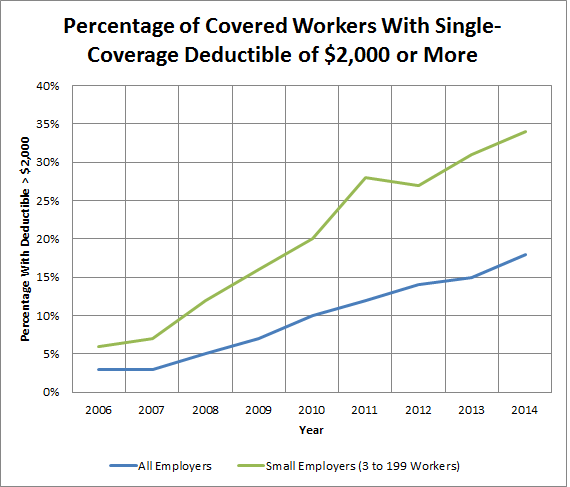
Source: StockMonkeys.com, Flickr.
After decades of rising prosperity in the 20th century, American workers have had to make do with flat to lower incomes in recent years. According to data from the U.S. Census, median U.S. household incomes have been flat over the past 25 years after adjusting for inflation, with declines since before the 2008 financial crisis and recession, and since incomes hit peak levels in 1999. Unfortunately, stagnant incomes haven't stopped workers from having to shoulder more of the burden in paying for their healthcare, with rising insurance premiums and increased deductibles combining to put even more financial stress on American families.
The misleading trend of health insurance premiums
Many policymakers make the mistake of thinking that healthcare costs are entirely baked into the premiums that workers pay for health insurance. According to a survey of employer-sponsored health benefits conducted by the Kaiser Family Foundation and the Health Research & Educational Trust, health insurance premiums have continued to grow at a pace higher than the typical worker raise since 1999. But more recently, the growth rate in those premiums has slowed, with an increase of just 2.4% from 2013 to 2014 suggesting that the double-digit percentage increases in what employers and employees pay combined for health insurance are a thing of the past.

Data source: Kaiser/HRET Survey of Employer-Sponsored Health Benefits.
But the problem workers face is that their employers are having them pay a greater portion of their combined health insurance premium cost, downwardly affecting take-home pay. The HRET/Kaiser survey found that the amount workers contribute toward their insurance premiums rose at a faster pace than total costs, with the total cumulative increase almost quadrupling the rate of increase in worker pay.
Getting less coverage for more money
If paying more got workers better coverage, then you could at least argue that taking on more of the costs was a fair trade. But the amount of money workers have to pay upfront before insurance benefits even start kicking in at all has risen at an alarming clip. In 2006, just 3% of workers who were covered by a health plan at work had to pay deductibles of $2,000 or more for single coverage. By 2014, that number had risen to 18%.

Data source: Kaiser/HRET Survey of Employer-Sponsored Health Benefits.
Moreover, those who work for small employers typically bear even more of the burden of financing their healthcare. More than one in three employees at companies with fewer than 200 workers have to pay $2,000 deductibles or higher. That's more than triple the percentage at large employers with 200 or more workers. Overall, deductibles have grown by nearly 50% in just the past five years, with averages climbing to $1,217 from just $826 in 2009. Workers at small companies have a huge disadvantage, though, with average deductibles approaching $1,800 compared to less than $975 for large employers.
At the highest end of the cost spectrum, though, there's been at least a bit of relief. In 2007, 29% of workers had out-of-pocket maximums above $6,350. That proportion fell to just 7% in 2014, largely because of limits imposed by the Affordable Care Act that took effect this year. Yet for those who routinely spend less than out-of-pocket maximums each year, those reductions won't have any benefit on the spending side, and many blame the new legislative limits for boosting premiums.
Know what you're getting
When unemployment levels hit their post-recession highs, workers had almost no leverage to demand better benefits from employers. As a result, it was easier for employers to push through efforts to put more of the costs of healthcare on their employees.
As conditions in the labor market improve, however, you have to be more aware not just of the salary you'll receive for your work, but also of the value of the benefits included in your pay package. If highly talented workers vote with their feet and choose employers who don't force them to bear ever-rising healthcare costs, then you could see the trend toward hitting workers hard on the healthcare front finally start to reverse in the future.
